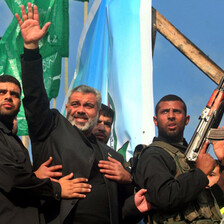The Electronic Intifada 8 December 2004

Today’s Israeli Ha’aretz newspaper brought good news to those disturbed by the relentless death toll resulting from the Israeli-Palestinian conflict; a headline that stated “IDF: 29 Palestinian civilians killed in W. Bank in 2004”.
“The Israel Defense Forces released figures Wednesday showing that since the beginning of the year,” wrote Ha’aretz correspondent Amos Harel, “148 Palestinians have been killed by IDF fire in the West Bank, at least 29 of them, by army count, innocent bystanders, Israel Radio reported Wednesday.”
With the IDF figures showing less than 3 “innocent” West Bank Palestinians killed each month during the year, one might conclude that Israeli commanders have been reining in their troops on the ground more effectively than earlier on in the 4-year-old Intifada which, according to the Palestine Red Crescent Society, has cost 3,465 Palestinian deaths and 28,230 Palestinian injuries up to midnight on December 7th.
Reading the Ha’aretz article closely, the first clue of statistical sophistry comes in the second paragraph, where we are told that, once the 29 innocent bystanders are subtracted from the total of 148, “the remaining 119 casualties include armed militants, along with firebomb and rock throwers.”
Having personally stood and watched young Palestinian stone throwers gunned down outside of stone-throwing range — therefore posing no conceivable threat to Israeli troops — I am left wondering how many of these “included” in the figure of 119 experienced similar fates?
Israeli human rights organisation B’Tselem, a favourite of American activists seeking to present “more credible” Israeli statistics to the US public, is cited later in the article to offer alternative figures, in which 187 (not 148) Palestinians were killed in the West Bank, 111 (not 29) of these were not involved in any fighting, and notes 13 cases in which the circumstances of death were unclear.
It is well known among researchers that there is a pattern of underestimating the numbers of Palestinian casualties. A year after the September 1996 Clashes, a team including myself, several Birzeit University staff and students, and a network of contacts around the West Bank and Gaza embarked on a project to find the stories of the Palestinians killed during the clashes, reduced to a negating two-digit number in media reports.
We began by visiting two different Palestinian government departments that keep records of Palestinians killed by Israel. The first item of interest was that both lists had slightly different totals and names, giving a total casualty figure in the 70-80 range. This was already higher than the figures reported in the media and human rights organisations outside the country, which typically put the Palestinian death toll between 50-65.
Human Rights Watch, for example, cites “at least sixty-two” as the number of Palestinians killed in its 1997 annual report. On 7 October 2000, Reuters offered a comparison statistic as background to its Intifada coverage that put the number of those killed during the September 1996 Clashes at just 60, 61 on its AlertNet country profile for Israel. On 1 October 2000, CNN reported that the figure was 59.
The confusion is not limited to non-Palestinian sources. In a 30 September 1996 note from Dr. Nasser Al-Kidwa, Permanent Observer of Palestine to the UN, to the Secretary-General of the United Nations, Al-Kidwa wrote, “…on 24 September 1996, the Israeli government opened an entrance to a tunnel in the vicinity of Al-Aqsa Mosque in occupied East Jerusalem, which led to tragic events resulting in a high number of casualties among Palestinian civilians caused by the Israeli army and police including more than 50 killed and over one thousand injured.” Similarly, the Palestinian Center for Human Rights in Gaza wrote “throughout the Occupied Territories a total of 64 Palestinians and 15 Israeli soldiers were killed and an estimated 1,600 wounded.”
During the Birzeit University project in 1997, after we checked the two Palestinian Authority lists and noted the few discrepancies, we deployed teams of people to literally visit the family of every single person killed during the September 1996 Clashes. Each team took testimonies from family members and friends about the lives — not deaths — of those killed, excluded the name of one man listed who was alive (his brother, not he, had been killed), tracked down additional martyrs not listed on the official documents, and corroborated this with newspaper reports and funeral notices that families had saved. We were ultimately able to determine conclusively that 88 Palestinians were killed.
The simple fact is that during times of intense conflict, those who are responsible for logging death in a society, doctors and nurses, are busy with other considerations. By 10:50PM on 25 September 1996, the first day of the clashes, the administrative director of Ramallah Hospital told me hospital records stated 4 Palestinians were killed and 253 injured. Two more men lay brain dead in the intensive care unit.
The sheer scale of the violence and the desperate attempts of the small hospital to cope with the numbers of injured — many of whom were victims of live ammunition — meant that typical hospital maintenance tasks such as cleaning blood off the floors and walls were deferred to later. In such a chaotic environment, particularly when periods of clashes and military occupations roll on for weeks as during the current Intifada, it is easy to understand how the dead can get lost.
In addition, Muslim burial beliefs pertaining to martyrdom sometimes results in those killed being taken directly to the graveyard for interment. For a variety of reasons, some practical and some cultural, conflict zones like these are not the best environments for sober research.
Why was the Israeli army announcement focused only on the casualty statistics in the West Bank? The answer was, ironically, nearby. A related link right next to the Ha’aretz article (see screenshot at top of page) reads “165 Palestinians, including 50 civilians, killed in October”. In one month, 30.3% of those killed across the whole country were found by Ha’aretz itself to be civilians, a figure almost double that which the IDF claimed for the entire year in the West Bank!
The report, by Arnon Regular, begins “The Israel Defense Forces killed 165 Palestinians in the territories in October, including 159 in the Gaza Strip. October was the deadliest month for the Palestinians since operation Defensive Shield in April 2002. An inquiry by Ha’aretz found that 50 of those killed (30.3 percent) were civilians, including women, the elderly, children and teenage boys under age 16; 115 (69.6 percent) were killed in the IDF operation launched in the northern Gaza Strip, on the outskirts of the Jebalya refugee camp and in the town of Beit Lahiya and Beit Hanun; and 39 percent of those killed in the northern Strip (some 45 people) were civilians.”
To further complete the wider, all-important contextual picture, try browsing the website of Remember These Children — found at www.rememberthesechildren.org — which records 152 Palestinian children and 11 Israeli children killed in 2004, and a total of 652 Palestinian and 117 Israeli children since the beginning of the Intifada. What was that Israel was saying about the West Bank? It suddenly seems a whole lot less important.

Gerard Araud
Israel’s public relations problems are considerable and are not going away, whatever its leaders and international friends may believe. The very notion of a press conference in which a military official highlights how many people the army has killed in a single geographic area — excluding the remainder of the country that simultaneously saw some of the worst violence in the history of the conflict — speaks of a deep moral void.
Even if the IDF’s laughable statistics were to be accepted at face value, what state has the Israeli establishment sunk to where it believes an announcement that 20% of those it kills — one person out of every five — were “innocent bystanders” is something to make noise about?
Related Links
Nigel Parry is a founder of the Electronic Intifada. He lived in the West Bank from 1994-1998, working in the Public Relations Office at Birzeit University and living in Ramallah. Today, he lives in Saint Paul, Minnesota and works as a web designer and Internet consultant through his business, nigelparry.net




